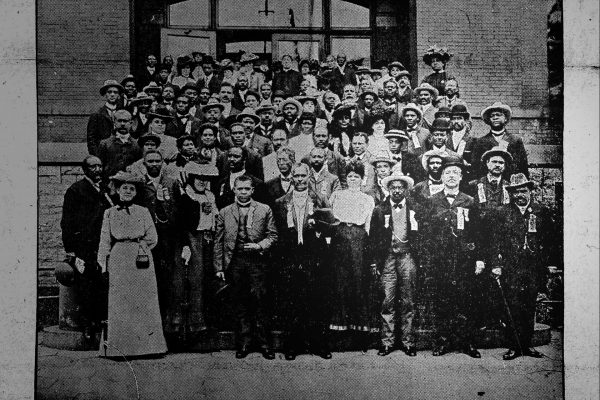When it was announced in fall 2017, Sidewalk Toronto promised to be a new high-tech development, set on Toronto’s waterfront, that would prioritize sustainability and affordability. The product of a partnership between Sidewalk Labs, a Google sister company, and Waterfront Toronto, a Canadian public land development corporation, the neighborhood would also pilot new technologies and add a Google office lakeside. Last week, after roughly two and a half years of pursuing approval for the project, Sidewalk Labs walked away, citing economic uncertainty due to COVID-19.
Governments continually conflate growing the tech sector with being consumed by it.
While the failure is certainly in part due to a changed world, this explanation brushes under the rug years of sustained public involvement in the project, from supporters and critics alike. From its inception, the project failed to appreciate the extent to which cities remain strongholds of democracy and democratic process.
The pitch for Sidewalk Toronto included autonomous vehicles, underground garbage robots, green energy infrastructure, snow-melting sidewalks, modular construction, wooden buildings, and more. Importantly, the project was underpinned by a real estate transaction, which was a major component of the deal. Sidewalk Labs sought to acquire or create a plan for a large amount of prime public land.
And as a smart city project, it was going to collect and use data to manage and define how the neighborhood worked. Data can be used to adjust traffic light timings, to automate parcel delivery in residential buildings through the use of delivery robots, to assess and seek to improve people’s recycling activities—the list of ways to measure activity and design systems to use this information is endless. Many parts of urban life—for example, park, transit, bicycle, and parking spot usage—can be captured by sensors, and that data in turn used to adjust and define how those systems are used, both in real-time and in the future. As Sidewalk Labs encapsulated that aim in its founding vision: “ubiquitous internet connectivity, social networks, sensing, machine learning and artificial intelligence, and new design and fabrication technologies — would help bring about a revolution in urban life.”
But from the beginning, Toronto residents raised substantive objections about the project across almost every domain: affordable housing, the amount of public land involved and its value, the governance of the technology systems (digital governance), the economic development plans, and more. In response, Waterfront Toronto did its best to negotiate terms and conditions it felt were defensible for all the communities and residents it had to answer to. No one wanted the deal to succeed more than Waterfront Toronto.
Over time, and through the public process, Waterfront Toronto took public input from all sides and negotiated for public value with Sidewalk Labs—mostly, unfortunately, behind closed doors. This was doubly problematic because, as a real estate corporation, Waterfront Toronto is not subject to freedom of information legislation. And beyond failing to be adequately open about its negotiations with Sidewalk Labs, Waterfront Toronto also fully abdicated responsibility for a core part of the project, right from the beginning. The digital governance part of Waterfront Toronto’s procurement document asked the following of respondents:
Create the required governance constructs to stimulate the growth of an urban innovation cluster, including legal frameworks (e.g. Intellectual Property, privacy, data sharing), financial considerations (including investment opportunities and revenue sharing expectations), deployment testbeds and project monitoring (KPI’s, reporting requirements and tools to capture data).
The document was, in effect, calling for the outsourcing of public governance to a for-profit actor. It’s difficult to believe the document even passed legal muster—that lawyers paid with public money approved it. But it speaks to an important policy problem: many things related to digital public governance are currently legal by default—not because they should be, but because rules haven’t kept pace with the tech industry or are being cowritten by it through lobbying. As a result, through public technology procurements, governments continually conflate growing the tech sector (economic development) with being consumed by it (outsourcing and automating public governance). Technology procurement is thus one of the largest democratic vulnerabilities that exists today.
• • •
Many things related to digital public governance are currently legal by default—not because they should be, but because rules haven’t kept pace with the industry or are being written by lobbyists.
While COVID-19 may have put the final nail in the coffin of Sidewalk Toronto, on the whole COVID-19 is exacerbating this governance problem. Two current examples: exceptional circumstances are being used to justify the implementation of immature technology, such as contract tracing apps. And New York is about to undergo intensive technology procurement as part of Governor Cuomo’s post-pandemic government strategy, explicitly naming education and health as areas of focus.
How these technologies are designed and implemented can be managed through public procurement. That procurement process can be informed by democratic principles and public oversight, or it can completely evade them. Regardless of the path, technology is still an immature regulatory space, which is the problem with things being legal by default instead of by intention. That is not how public governance is meant to work: the application of technologies across public systems is not an individual consumer choice; as such, they should be properly regulated as public goods.
Smart city projects can and do privatize governance in insidious ways, particularly when the entire environment is being laid out by a single corporate actor. Being the mapmaker is where the major power lies, as history illustrates. Part of what made Sidewalk Toronto so problematic, from a governance perspective, was the power it threatened to hand over to Sidewalk Labs to lay out the infrastructure design of a large swathe of public and private space.
For example, a number of Sidewalk Labs’ plans for Sidewalk Toronto merged the physical with the digital in ways that could have turned publicly managed infrastructure into markets where mediating companies could do business. Its business model—one common across the tech sector—was to collect detailed data through sensors and software (digital infrastructure)—on parking, how public space is used, energy consumption, waste management, transportation, telecommunications—with the goal of later establishing markets around influencing how these assets are accessed, priced, and used. But the critical first step was simply the creation of an elaborate digital infrastructure designed as a dragnet.
Here, fortunately, there was major public pushback because Waterfront Toronto did not have public consent to establish this infrastructure, and the city of Toronto didn’t yet have a plan for how to design it democratically.
Sidewalk Toronto’s demise doesn’t bode well for other corporate-led smart city ventures seeking to establish these vast infrastructures, but the component parts of technologies they were pitching will live on. Many cities already use smart city technology and have for a long time, but in most cities the mix of technology comes together in a much more piecemeal and scattershot way, over time. The technologies that were to be piloted in Toronto will likely make their way into other cities and other real estate development plans, and possibly with less public scrutiny because they arrive as one-offs rather than a package deal. Sidewalk Labs’ Replica city-planning data product is one such example, already in use in several U.S. states, as is Sidewalk Infrastructure Partners, a company spun out of the project last year.
The issue is not only one of having inadequate rules in place. There must also be political will.
In the case of Sidewalk Toronto, the city’s residents were faced with the task of mitigating corporate product designs for their city before they had even properly reflected on how they might wish (or not wish) for tech to be designed for public purpose, never mind which tech or which public purposes. Reacting to corporate products instead of proactively defining policy is called regulatory capture—products inform policy simply because they exist, and this is precisely what was happening with Sidewalk Toronto. Theft of future alternatives through distraction with the now.
Firms such as Sidewalk Labs are not just offering products, they are getting governments to procure entire business models, and thus act as both regulator and regulated. To state the obvious, it is undemocratic to have vendors set public policy. But the oversight processes we currently have—designed with the procurement of snowplows and sewers in mind—are woefully insufficient for helping governments navigate the power dynamics of private investment in digital infrastructure. Indeed, they are arguably inadequate even for more conventional kinds of procurement; governments, after all, get scammed by vendors all the time. Public procurement will continue to be gamed to the benefit of the tech sector—and to the detriment of democracy—until we reimagine it for the digital era.
• • •
The issue, though, is not only one of having inadequate rules in place. There must also be political will. In the case of Sidewalk Toronto, the sitting governments were all but paralyzed by the fear of doing something that would cause Toronto or Canada to gain the reputation of being hostile to the tech sector. Indeed, the cultural insecurity of Toronto and Canada—long part of its relationship with the United States—kept the project alive well past the date a responsible government would have stopped it.
Belatedly, and in response to mounting public pressure, the City of Toronto recently set to work on creating a digital infrastructure policy in an attempt to respond to the issues raised by Sidewalk Toronto. This implicitly confirmed that the project had been happening in a policy vacuum. Indeed, a range of experts on Waterfront Toronto’s Digital Strategy Advisory Panel, an independent body created to provide advice to the public agency, had specifically noted this as a hindrance in their work on Sidewalk Toronto. In their words, they saw a “lack of a fully realized digital governance framework and the need for expedited public sector leadership.” Put another way, some members did not feel they had adequate democratic guidance to properly assess the risks and opportunities of the project. Nonetheless, many were keen to work through these issues with Sidewalk Labs and saw the project as an opportunity to do so.
The issue of digital privacy became both a flashpoint of public anger and much confusion. Sidewalk Labs partially brought the privacy conversation on itself by having Ann Cavoukian, a former privacy commissioner and inventor of the “Privacy by Design” concept, as part of their launch team. But this also became its own sort of trap, with public discussion unable to move beyond discussion of how the project would guarantee privacy to talk about why the data needed to exist in the first place. Could any of the purported benefits of its collection—how it would be used to manage a range of public systems efficiently—actually bear up under scrutiny?
Instead privacy, as so often happens, became its own kind of permission, as in, if personal privacy is covered, it’s fine, and never mind whether the data benefits the public. This is lazy thinking, and it is encouraging to see the city of Toronto undertake serious deliberation about digital governance beyond privacy.
As so often happens, privacy became its own kind of permission—as in, if personal privacy is covered, it’s fine, and never mind whether the data benefits the public.
In its process, the city should consider ways of helping the public to better appreciate what is at stake in different kinds of questions about public governance. Private actors understand that it is beneficial to sow confusion, and do their best to fragment public discussion into dozens of tiny pieces, none of which on their own seem terribly significant. In the case of Sidewalk Toronto, for example, because the project was asking for the public’s tolerance for something so broad and expansive as a major real estate development, the public couldn’t separate out the big and important items (such as a lack of digital policy) from the small and distracting ones (such as raincoats for buildings).
Put another way, if you list hundreds of items in one spreadsheet, each row appears to possess equal weight. But in this project, each row was not the same. The creation and use of “distributed verifiable credentials for data sharing” is very different than heated paving tiles that melt snow. By lumping them all together, however, Sidewalk Labs successfully divided stakeholders, and that divisiveness is particularly palpable now that the project has fallen apart. Many urbanists, for example, were excited about the project’s tall timber buildings, its garbage management solutions, and its playful safe streets. And why wouldn’t they be? These are good ideas. But not if they come at the cost of future public regulatory design power and public value.
Likewise, some members of the public supported the project’s attempts to mitigate the effects of the climate crisis. Of course we should do climate-positive things in Toronto—no one was ever arguing against that point. But why would we mix climate solutions in with digital policy development? One is about sustainability while the other is about public power and control—and we shouldn’t sacrifice one in order to get the other. Same with financing transportation infrastructure. Or generating public benefit from a piece of public land. We should be starting with these kinds of shared goals, and carefully considering if and how individual technology components can achieve them, with a strong digital policy to guide decision-making.
• • •
It has never been more critical than it is now for cities to develop robust public processes for adopting urban technologies—which can be anything from a digital identity card for accessing public services to the software used to sign up for rec programs. For the past twenty years, municipalities have adopted technologies on an ad hoc basis with almost no consideration for what kind of policy or vision should guide those choices; this loose state of affairs is simply not sustainable. How do these systems seek to assert influence on public life? Who do they impact and how? How does access to public services evolve with their use, particularly over time? Technology, historically, entrenches and accelerates preexisting inequities. Technologies generally do not serve all people the same—which is precisely what governments have a formal responsibility to do.
Cities have long struggled with the complicated challenge of serving their residents equitably—from transportation and public health to economic development. These struggles are now further complicated by COVID-19. And while there is scant evidence the tech sector can handle these challenges any better than governments (indeed, years of private–public partnerships suggest the opposite), tech firms are constantly turning up in government buildings to pitch new promises of efficient service. As money runs increasingly short in cities due to the pandemic, everyone will be looking for quick fixes.
Against the understandable urge to accept such easy solutions, cognitive scientist Abeba Birhane offers wise council:
Many of the ‘problems’ in the social sphere are moving targets, challenges that require continual negotiations, revisions, and iterations—not static and neat problems that we can ‘solve’ once and for all. This attitude is so well engrained within the computational enterprise, a field built on ‘solving problems,’ that every messy social situation is packaged into a neat ‘problem –> solution’ approach. In the process, challenges that cannot be formulated into neat ‘problems’ are either left behind or stripped of their rich complexities.
Birhane’s words capture what is so important about cities and democracy both: their messiness. At their heart, urban challenges are not technical, they are political.
Municipalities have been adopting technologies on an ad hoc basis with almost no consideration for what kind of policy or vision should guide those choices; this loose state of affairs is simply not sustainable.
Toronto’s residents, housing advocates, and planning community have incredible vision for the public waterfront land (indeed, they have for decades), and it is that vision, rather than an imposed technocratic solution, that should be allowed to take shape. The waterfront needs infrastructure investments in housing and transportation as a baseline, full stop; these aren’t things to bargain with at the cost of other public rights and future public value. The procurement for this project was always destined to fail once public oversight kicked in. There was no way to do the calculus related to the public value and trade-offs of the component parts of the tender. It was too much at once, and too speculative.
Waterfront Toronto did the right thing by seeking fair public value for the land, and in the deal. Democracy worked. It was slow, it was messy, but it worked. Sidewalk Labs did not have to answer to the people. The governments do and did. And yet along the way, the economic development allure of the tech sector proved to be candy to Canadian politicians and some established urbanists alike. The newness of it all presenting a way to appear relevant, progressive, and innovative without actually adjusting foundational blockages to freedom, equity, and climate justice.
Technologies, of course, have a role to play in our cities. But cities and the public must be allowed to define how our digital infrastructures function; how they impact how we live, work, and play together; and how we pay for them. We already have experience in designing frameworks for projects of similar complexity, such as environmental assessments, which importantly include a “do nothing” option. Once we establish defensible ways to understand the impacts and trade-offs of technology, and the types of ways we do and don’t want to commodify data and digital infrastructures, we will be able to properly use tech as one tool of many to address the deep and pervasive problems we face in our cities.
One lesson to learn from Sidewalk Toronto is to look to procurement as a line of defense and a way to assert public guidance on technology. However we do it, we must continue to fight to keep political control of our public systems and to reject the idea that technologies are inevitable. One of the many problems with private tech and public systems is the hardening of the type of privatization they enable, the loss of the governance layer that defines how they operate. It is important to hold this line, and to shift power back to the public to define digital futures instead of allowing them, in confusion and fear, to be dictated to us.








